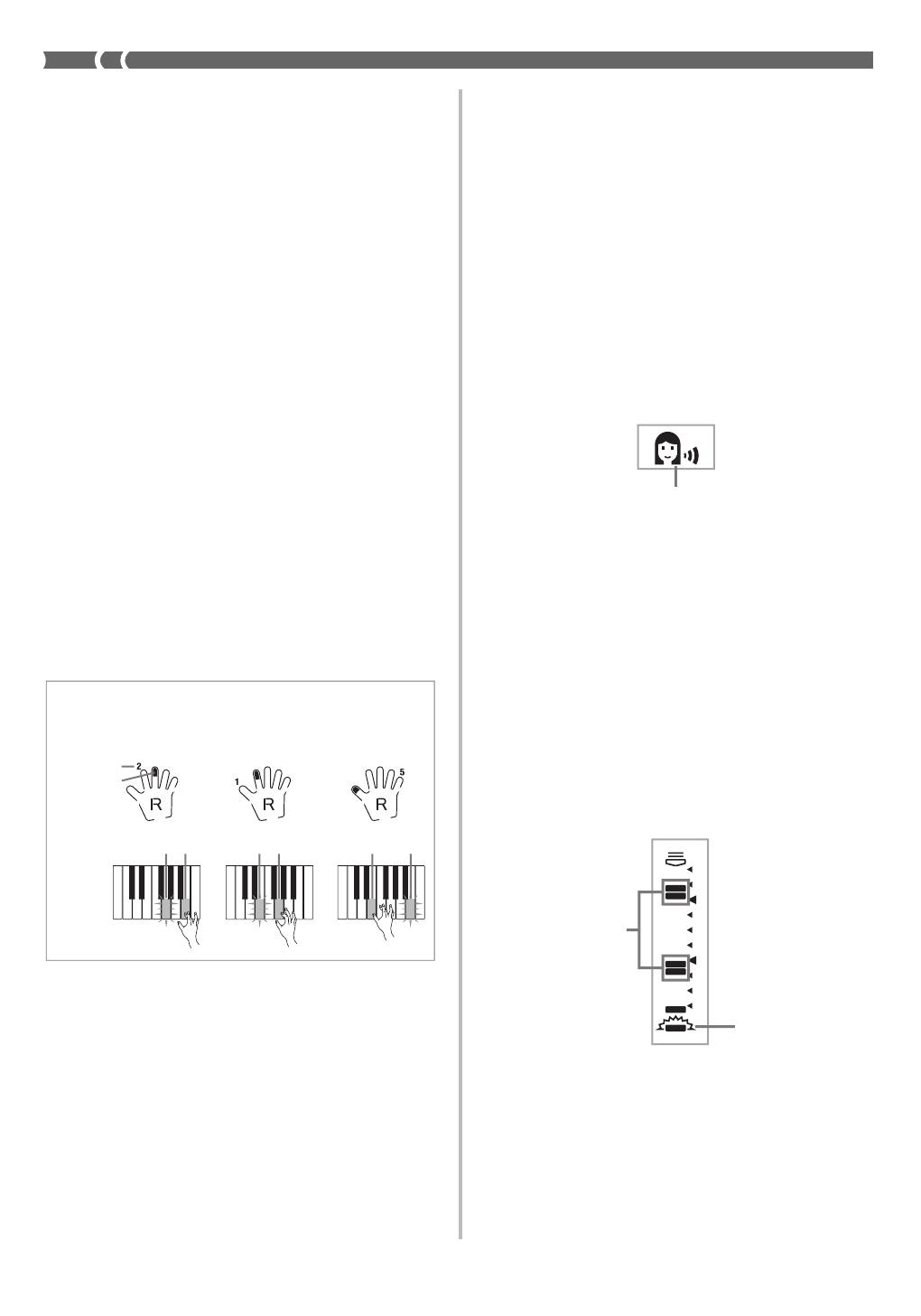
S-22
Operación del sistema de iluminación de
tecla y contenidos del display durante la
ejecución de lección de 3 pasos
Siempre que selecciona una melodía (00 a la 83) del
acompañamiento automático para la ejecución de la lección
de 3 pasos, el sistema de iluminación de tecla le muestra qué
teclas presionar, mientras el display le muestra la digitación.
Altura tonal de nota
La tecla del teclado que debe presionar se ilumina. Los dedos
que debe usar para ejecutar las notas también se muestran
sobre el display.
Longitud de nota
Las teclas del teclado permanecen iluminada durante el
tiempo en que la nota debe ser ejecutada. Las digitación
también permanecen sobre el display durante la duración de
la nota.
Nota siguiente
La tecla del teclado para la nota siguiente a ser ejecutada
destella, mientras aparece un número sobre el display
próximo al dedo que debe usar para ejecutar la nota siguiente.
Serie de notas con la misma altura tonal
La tecla del teclado se desactiva momentáneamente entre las
notas, y se ilumina de nuevo para cada nota sucesiva. Las
digitaciones también se desactivan y activan de nuevo.
Ejemplo: Cuando la ejecución requiere la presión de las
teclas con los dedos 3, 2 y luego 1
❚
NOTA
• La longitud de nota no se indica cuando se utilizan las melodías
con dos manos (84 a 99) con los pasos 1 y 2 de la lección de 3
pasos. Tan pronto como presiona una tecla iluminada, la tecla
se apaga y la tecla siguiente a ser ejecutada comienza a
destellar.
• La longitud de nota se indica mediante el sistema de iluminación
de tecla cuando se usa una melodía con dos manos con el
paso 3. En este caso, la tecla siguiente a ser presionada no
destella cuando se presiona una tecla iluminada, y el número
de dedo siguiente no aparece sobre la presentación. Solamente
se muestra el número de dedo actual.
Nota siguiente
Nota actual
1ra. Nota 2da. Nota 3ra. Nota
Destello Iluminado Destello Iluminado DestelloIluminado
Luz de tecla
Guía de digitación por voz
La guía de digitación por voz utliza una voz humana simulada
para llamar los números de la digitación, durante una práctica
de parte de una mano de los pasos 1 y 2. Si necesita presionar
una tecla con su pulgar, por ejemplo, la guía de digitación
por voz dice, “One!” en inglés. En los casos de un acorde a ser
ejecutado con su dedo pulgar, medio y meñique, la guía de
digitación por voz dice, “One, three, five!”.
La guía de digitación por voz llama las digitaciones solamente
cuando no presiona la tecla apropiada cuando debe hacerlo.
Para activar y desactivar la guía de
digitación por voz
Para activar y desactivar la guía de digitación por voz, utilice
el botón SPEAK.
Indicador de sincronización
El indicador de sincronización ayuda a familiarizarse con las
melodías que toca por primera vez, indicando la
sincronización de las notas que ejecuta en el teclado. La
sincronización es más fácil de ver cuando utiliza un tempo
lento durante la ejecución de lección.
Usando el indicador de sincronización
El indicador de sincronización le muestra la sincronización
de las notas contenidas en la parte seleccionada actualmente
(R o L). Las notas se indican como bloques de dos segmentos
que se desplazan desde la parte superior del display, hacia
abajo a la parte inferior. Una nota se ejecuta cuando su bloque
alcanza la parte inferior del display.
• Cada bloque de dos segmentos puede indicar una o más
notas, dependiendo en la melodía que está ejecutando.
❚
NOTA
• El indicador de sincronización muestra la sincronización de
las notas siempre que se reproduce una melodía del banco de
canciones y durante la lección de 3 pasos.
• Tenga en cuenta que el indicador de sincronización muestra
sólo una sincronización aproximada.
Indicador de guía de digitación por voz
Sincronización de
la nota por venir
Nota ejecutada aquí
LK120_s_20-25.p65 10.3.25, 4:37 PM22



































































